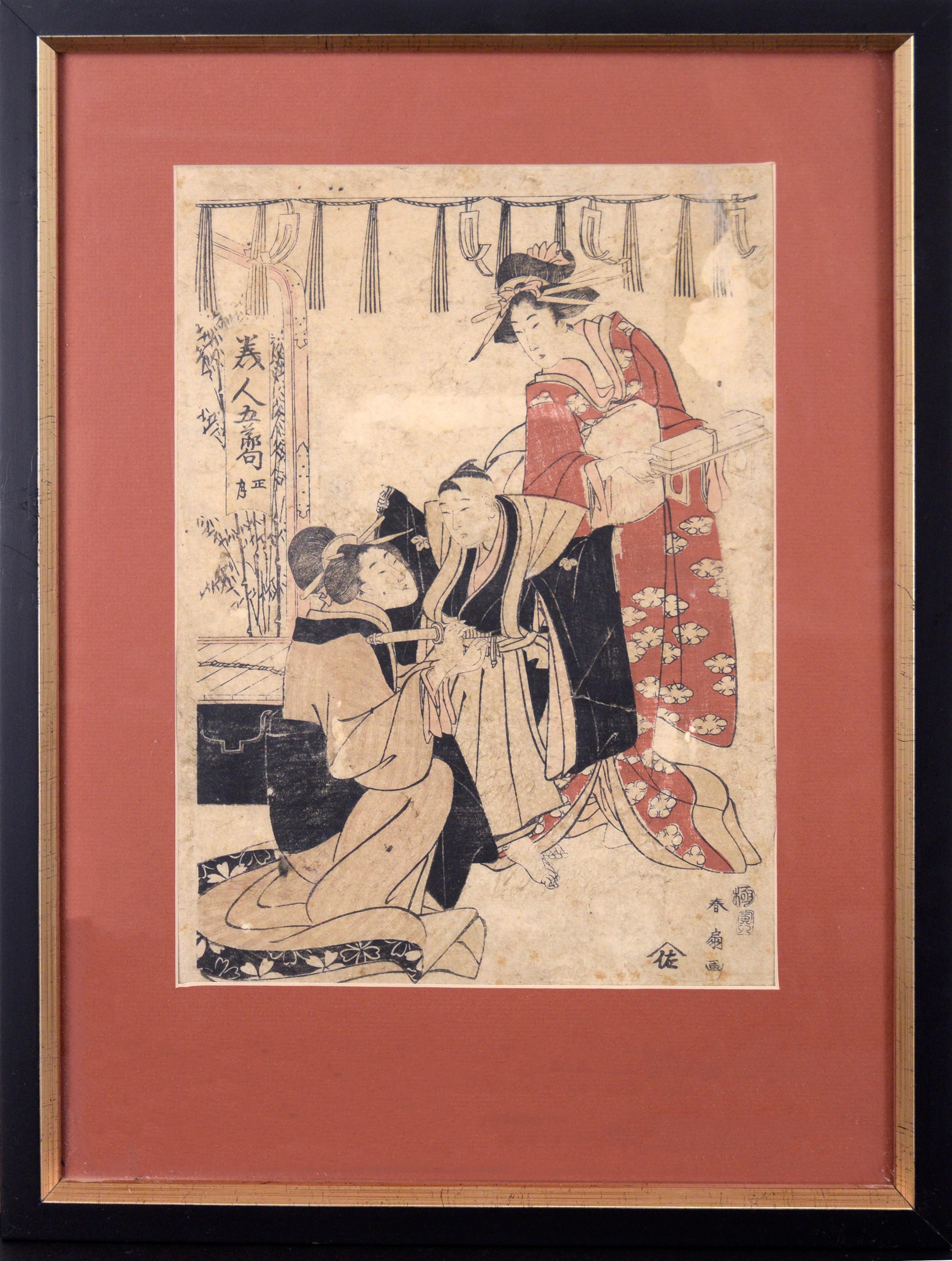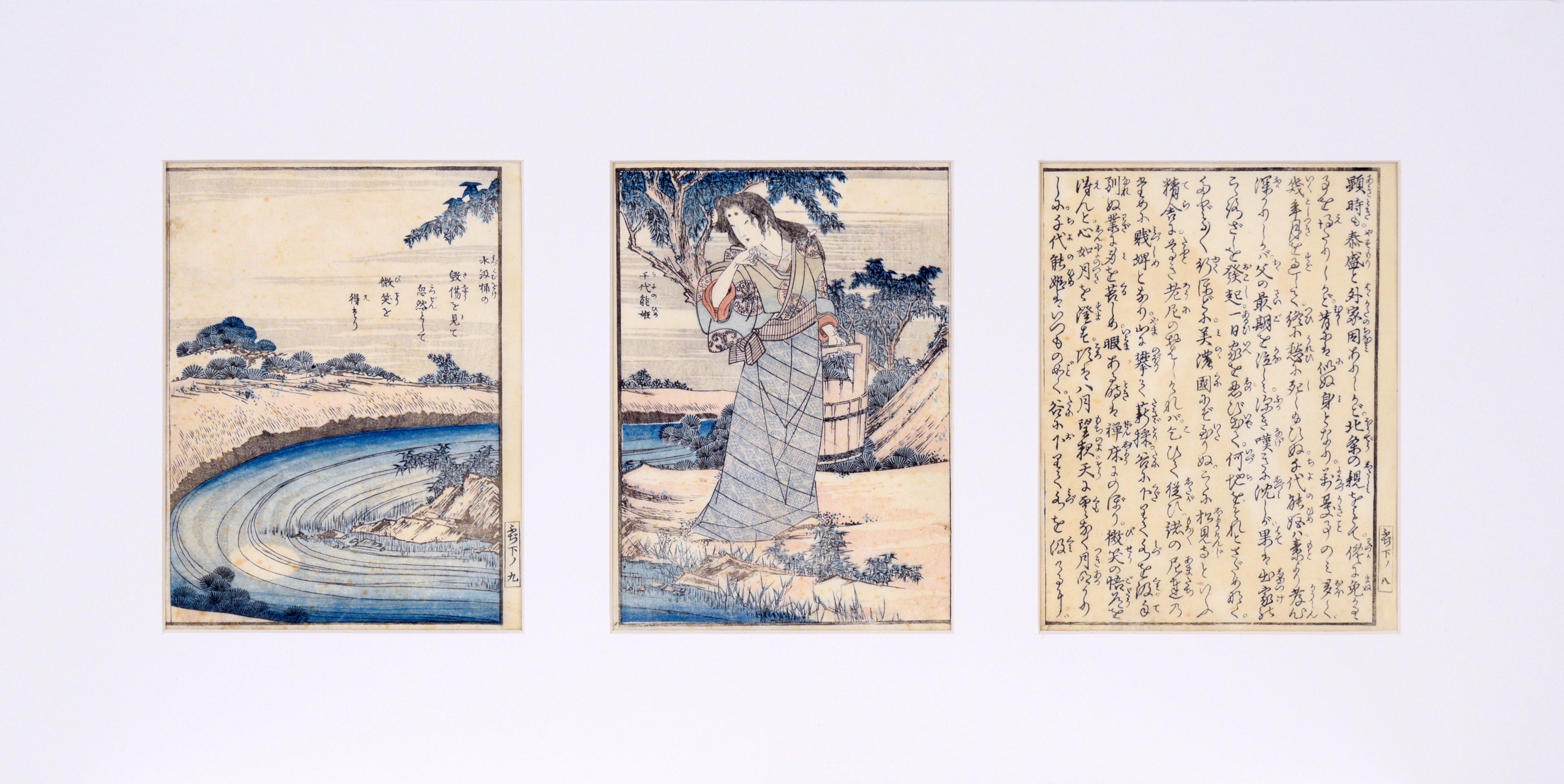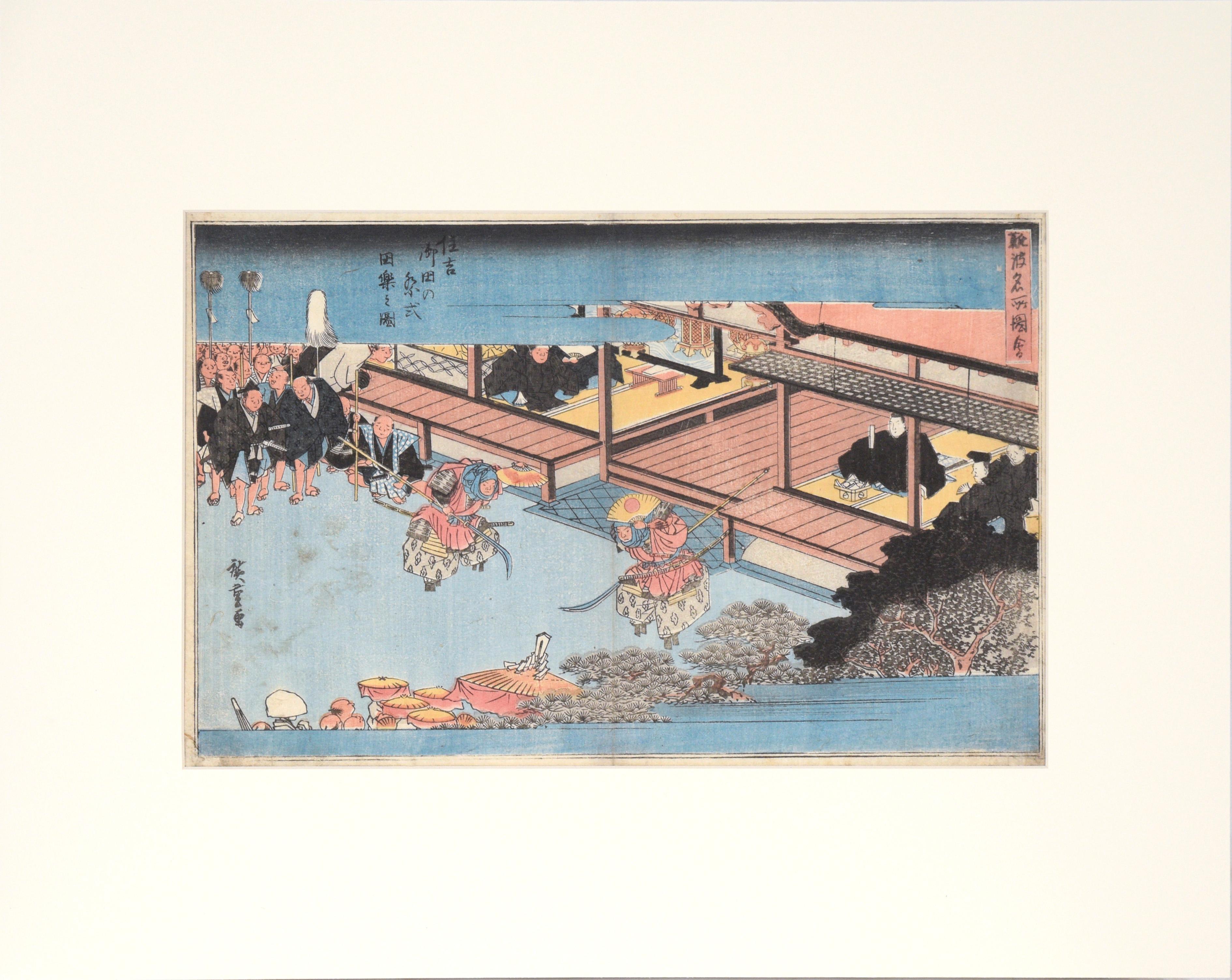Items Similar to "Shirasuka Rokuro" - Mid 19th Century Figurative Japanese Woodblock Print
Want more images or videos?
Request additional images or videos from the seller
1 of 13
Utagawa Kunisada (Toyokuni III)"Shirasuka Rokuro" - Mid 19th Century Figurative Japanese Woodblock Print1850
1850
About the Item
"Shirasuka Rokuro" - Mid 19th Century Figurative Japanese Woodblock Print
Beautiful mid 19th century figural Japanese woodblock print of a samurai named Shirasuka Rokuro by Utagawa Toyokuni III (Kunisada) (Japanese, 1786-1864/5). The samurai is holding a spear, standing under a tree with full blossoms. He is wearing an elaborate outfit, including two swords. Artist's signature and chop are in the lower left corner of the piece.
Presented in a wood frame with a cream mat.
Frame size: 21.5"H x 16.5"W
Image size: 13.75"H x 9.5"W
During his lifetime Kunisada Utagawa was considered to be the best print designer by his contemporaries. He was more popular than Hiroshige, Hokusai or Kuniyoshi. And Kunisada was extremely productive. His total output is estimated at more than 20,000 designs, many made by his students.
Kunisada was born near Edo (today Tokyo) as the son of an affluent merchant with a ferry boat license. At the age of fifteen he joined the famous art school of Utagawa Toyokuni and took the name Kunisada.
In 1807 the young artist produced his first illustrated book. And in 1808 his first actor prints were published. His fame grew fast. While other artists like Kuniyoshi Utagawa or Hiroshige had to fight for recognition for years, he was successful from the beginning.
He should become the most commercially successful of all woodblock printmakers ever. His early success may not have had a good influence on his personality. He had a reputation for his conceited personality.
Kunisada designed a wide spectrum of traditional ukiyo-e subjects like kabuki themes, beautiful women, historical events and quite a few shunga prints. He made few landscapes.
- Creator:Utagawa Kunisada (Toyokuni III) (1786-1864, Japanese)
- Creation Year:1850
- Dimensions:Height: 21.5 in (54.61 cm)Width: 16.5 in (41.91 cm)Depth: 0.5 in (1.27 cm)
- Medium:
- Movement & Style:
- Period:
- Condition:Some age toning to paper. Crease visible along left edge.
- Gallery Location:Soquel, CA
- Reference Number:
Utagawa Kunisada (Toyokuni III)
Born in the Honjo district of Edo as Kunisada Tsunoda, Kunisada’s family owned a small hereditary ferryboat service. Though his father, an amateur poet, died when Kunisada was a child, the family business provided some financial security. During his childhood, he showed considerable promise in painting and drawing. Due to strong familial ties with literary and theatrical circles, he spent time studying actor portraits. At age 14, he was admitted to study under Toyokuni, head of the Utagawa school. Kunisada's work embodies the characteristics of the Utagawa school, focusing on traditional subjects such as kabuki, bijin (beautiful women), shunga (erotic prints), and historical prints. His first known print dates to 1807, his first illustrated book to 1808. Kunisada’s career took off from the beginning. Many of his works became overnight successes and he was considered the “star attraction†of the Utagawa school. He signed his works “Kunisada,†sometimes with the studio names of Gototei and Kochoro affixed. In 1844, he adopted the name of his teacher and became Toyokuni III. Kunisada passed away in 1864 in the same neighborhood that he was born. He was 70 years old. Kunis
About the Seller
4.9
Platinum Seller
These expertly vetted sellers are 1stDibs' most experienced sellers and are rated highest by our customers.
Established in 1986
1stDibs seller since 2014
2,549 sales on 1stDibs
Typical response time: <1 hour
- ShippingRetrieving quote...Ships From: Soquel, CA
- Return PolicyA return for this item may be initiated within 14 days of delivery.
More From This SellerView All
- The Pilgrimage Procession to Kinryuzan Temple at Asakusa in the Eastern CapitalBy KuniyasuLocated in Soquel, CAJapanese Parade - Woodblock Print Japanese woodblock print by Utagawa Kuniyasu (歌川 国安) (Japan, 1794–1832). Japanese women, dressed in blue and red kimonos, are the focal point. A vi...Category
Mid-19th Century Edo Figurative Prints
MaterialsPaper, Ink, Woodcut
- Dressing the Boy Samurai - Kuniyoshi Japanese Woodblock Print Original Wood CutBy Utagawa KuniyoshiLocated in Soquel, CADressing the Boy Samurai - Kuniyoshi Japanese Woodblock Print Original Wood Cut A young Samurai boy is finishing dressing with the help of a younger sister while his mother looks on ...Category
1850s Edo Figurative Prints
MaterialsPaper, Ink, Woodcut
- Japanese Artisans - Silk Dying -Japanese Woodblock PrintBy Tosa MitsuyoshiLocated in Soquel, CAJapanese Artisans - Japanese Woodblock Print J Japanese woodblock depicting six women, all wearing vibrant kimonos, working on crafts by Tosa Mitsuoki (Japanese, 1617-1691). Japanese,c. 1600. Handcraft depiction (dye works).Section from a painted screen with presentations of handcraft.Kita-in, Saitama. Stamped lower left. Presented in a white mat and giltwood frame. Frame: 19"H x 14"W Mat: 18.25"H x 13.25"W Image: 14.5"H x 9.5"W Tosa Mitsuoki was a Japanese painter, reinvigorating the Yamato style of classical Japanese painting. Yamato-e originated from interest in reproducing early Tang dynasty paintings, and was later reinvented and further refined to fit Japanese cultural perceptions in the late Heian period. Yamato, sometimes referred to as wa or kazu had become synonymous with the Tosa-ha by the Muromachi period as a way for Japanese artist to distinguish their works from those of mainland Chinese paintings, kara-e. Yamato-e incorporated various visual and literary techniques for establishing narrative. Works were not always accompanied with text and may rely on heavily on period specific visual motifs, icons, and symbols to relay a story or theme. Tosa style by the time of Mitsuoki focused heavily on depicting themes of plants and nature, famous places, meisho, the four seasons, shik, bird-and-flower, kacho. Many of these popular symbols and icons from mimicking Chinese practices, treating the original Chinese masterwork as a sort of prototype to improve upon. Popular formats for Mitsuoki's pictures were wall scrolls kakemono, or handscrolls that would be read from right to left with the accompanied story, sliding doors fusuma and folding screen panels byobu that featured up to six panels. Mitsuoki's style incorporated the depth and calligraphy techniques of ink wash brushwork similar to Song dynasty and Yuan dynasty Chinese court paintings...Category
1920s Edo Landscape Paintings
MaterialsPaper, Ink, Woodcut
- 3 Panel Hand Colored Japanese Woodcut Print LithographBy Keisai EisenLocated in Soquel, CA3 Panel Hand Colored Japanese Woodcut Print Lithograph Three panel hand colored woodcut lithograph from Nanso Satomi hakkenden, Tale of the Eight Dogs...Category
Early 19th Century Edo Figurative Prints
MaterialsPaper, Ink, Woodcut
- Sumiyoshi: Dengaku dance performed during an Onda ceremony - Woodblock PrintBy Utagawa HiroshigeLocated in Soquel, CASumiyoshi: Dengaku dance performed during an Onda ceremony - Woodblock Print Bright woodblock print by Utagawa Hiroshige (Japanese, 1797-1858). In this scene, two dancers with swords and fans are facing each other, in the center of a courtyard. There are spectators surrounding them, including nobles in black clothing on a balcony. Presented in a new off-white mat with foamcore backing. Mat size: 16"H x 20"W Paper size: 9.63"H x 14.5W" Utagawa Hiroshige (1797-1858, sometimes called Ando Hiroshige) was the second of the two great masters of the Japanese landscape woodblock print...Category
1830s Edo Figurative Prints
MaterialsInk, Rice Paper, Woodcut
- Beauties Mirrored in the Forms of Flowers - Utagawa Kuniyoshi Japanese WoodblockBy Utagawa KuniyoshiLocated in Soquel, CABeauties Mirrored in the Forms of Flowers - Utagawa Kuniyoshi Japanese Woodblock A Japanese beauty dressed and posed resembling flowers by Utagawa Kumiyoshi (Japan, 1797 - 1861 ). A...Category
Mid-19th Century Edo Figurative Prints
MaterialsPaper, Ink, Woodcut
You May Also Like
- Seishi Ai-oi Genji – Set of 12 Shunga works together w/astrological commentaryBy Utagawa Kunisada (Toyokuni III)Located in Middletown, NYSet of 12 woodblock prints in colors on handmade, laid mulberry paper, 6 3/4 x 10 1/4 inches (170 x 258 mm), printed in Ka-ei 4 (1851). Each print with minor handling wear, otherwise in excellent condition with bright and fresh color, and with details printed in silver ink. The images themselves contain several illusive characters indicating the publisher which are obfuscated by figures, as intended. Presented loose, as issued. A fine set. The astrological commentary print has a large and meandering blind stamp with a bird and palm frond motif. This print lists various phrases concerning the Twelve Zodiac Animals as historically counted in Japan, and appears to include erotic commentary on the traits of people born under each of the twelve signs. These Shunga images were issued in books that paralleled (in an erotic fashion...Category
Mid-19th Century Edo Nude Prints
MaterialsHandmade Paper, Ink, Woodcut
- Toshogu ShrineLocated in Middletown, NYIn image of the Tokugawa family paying homage to Tosho-gu Shrine in Nikko. Tokyo: Matsuki Heikichi, 1896 Woodcut in ink with embossing and hand-coloring in watercolor on handmade m...Category
Late 19th Century Edo Figurative Prints
MaterialsHandmade Paper, Watercolor, Woodcut
- The Lonely House at Asajigahara.Located in Middletown, NYA scene from a series of ghost stories and spooky rural legends. Tokyo: Matsuki Heikichi, 1896. Woodcut in ink with embossing and hand-coloring in watercolor on handmade mulberry pa...Category
Late 19th Century Edo Figurative Prints
MaterialsWatercolor, Woodcut, Handmade Paper
- Actor Iwai Shigaku as Somenoi in "Denka chaya adauchi"By KuniyoshiLocated in Middletown, NYActor Iwai Shigaku as Somenoi in "Denka chaya adauchi" (Revenge at the Denka Teahouse), by Shigeharu, Ryusai (also called Kuniyoshi) Tokyo: Horie Ichiba Wataki, 1835. Woodcut on la...Category
Early 19th Century Edo Portrait Prints
MaterialsLaid Paper, Handmade Paper, Woodcut
- Dyeing PaperLocated in Middletown, NYJapan: circa 1770. Woodcut on cream laid paper, 7 1/4 x 2 1/2 inches (182 x 63 mm), narrow margins. Laid down to non-archival board with scattered soiling and some adhesive staining...Category
Late 18th Century Edo Figurative Prints
MaterialsHandmade Paper, Woodcut, Laid Paper
- 19th century color woodcut Japanese ukiyo-e print female geisha figure signedBy Utagawa KuniyoshiLocated in Milwaukee, WIThis print is from a highly regarded series by the Edo woodblock artist Utagawa Kuniyoshi: in the period, there were at times prohibitions in depicting a...Category
1850s Edo Figurative Prints
MaterialsPaper, Pigment, Woodcut
Recently Viewed
View AllMore Ways To Browse
Framed Mid Century Prints
Japanese Mid Century Design
Framed 19th Century Prints
Japanese Midcentury Design
Japanese Mid Century Wood
Mid Century Japanese Paper
Japanese Woodblock Prints Framed
Japanese Mid Century Woodblock
Mid Century Japanese Woodblock Print
Midcentury Japanese Woodblock Prints
Edo Woodcuts
Contemporary Woodblock Japanese Print
All Japanese Woodblock Prints
Japanese Edo Woodcut
19th Century Japanese Figure
Famous Japanese Woodblock Prints
Kabuki Print
Trees Woodcut Print






